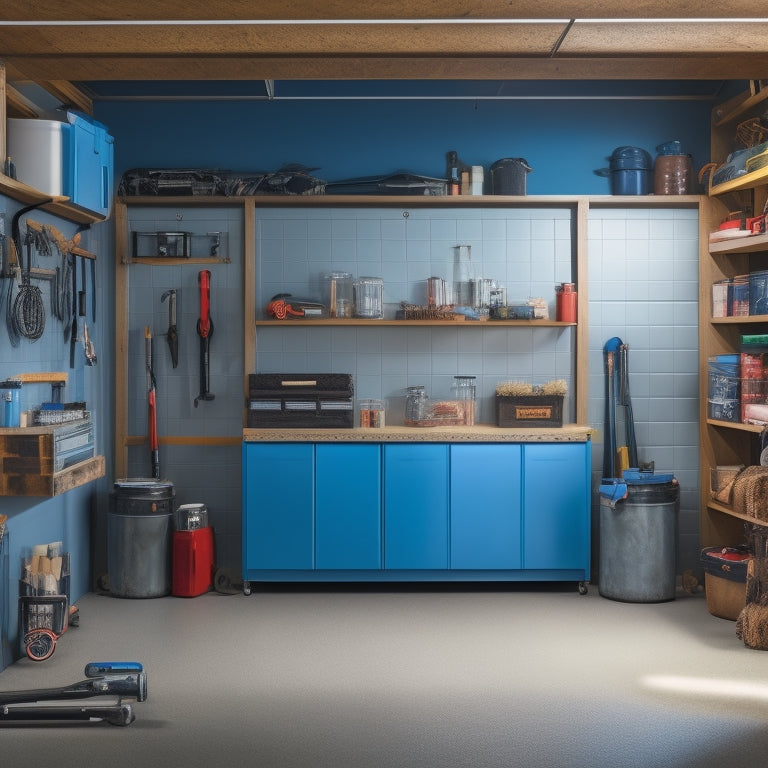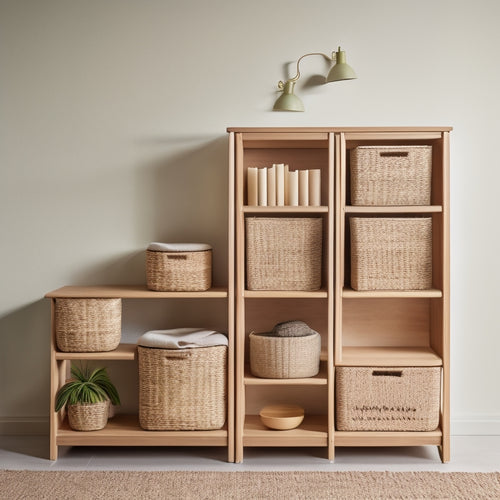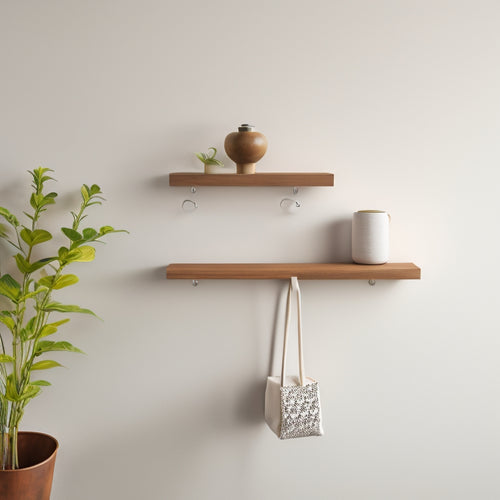
Wall Mounted Garage Storage Cabinet Installation Considerations
Share
As you prepare to install a wall-mounted garage storage cabinet, it's vital to take into account a few essential factors. First, assess your garage wall space, measuring dimensions and checking for obstacles like outlets and uneven surfaces. Choose a cabinet that fits your style and storage needs, and take precise measurements to guarantee a perfect fit. Prepare your wall by inspecting for damage, locating studs, and cleaning the surface. By evaluating cabinet weight and capacity, you'll guarantee a safe and secure installation. Next, you'll need to select the right anchors, think about door clearance, and secure the cabinet to the wall - and that's just the beginning.
Key Takeaways
- Measure garage wall dimensions to identify suitable cabinet installation areas, considering wall material and obstacles like electrical outlets.
- Choose cabinets with durable materials, safety features, and suitable storage capacity for intended items and garage conditions.
- Ensure precise measurements of cabinet space and wall clearance to prevent installation errors and ensure a comfortable fit.
- Prepare the wall for installation by cleaning, locating studs, and inspecting for damage, and select appropriate fasteners for the wall type.
- Select reliable anchoring options that can support cabinet weight and contents, and follow manufacturer recommendations for anchoring methods and materials.
Assessing Garage Wall Space
Measure your garage wall space to determine the ideal location for your wall mounted garage storage cabinet.
Take into account the dimensions of your cabinet and the available space on your garage wall. Consider the garage wall materials, such as drywall, plywood, or concrete, to guarantee the cabinet's weight can be supported.
Next, assess the wall space organization.
Look for any obstacles, like electrical outlets, switches, or plumbing, that might interfere with the cabinet's installation. Check for any uneven surfaces or studs that could affect the cabinet's stability.
Identify any areas with high traffic or frequent use, such as near a workbench or toolbox, and plan to install the cabinet in a convenient yet out-of-the-way location.
Choosing the Right Cabinet
With your garage wall space assessed, you're now ready to select the perfect cabinet for your storage needs. This decision is vital as it will impact the functionality and safety of your garage.
When choosing the right cabinet, consider the following key factors:
-
Style preferences: Think about the overall aesthetic you want to achieve in your garage. Do you prefer a modern, sleek look or a more traditional design?
-
Material durability: Cabinets made from high-quality materials like steel or heavy-duty plastic can withstand heavy use and harsh garage conditions.
-
Storage capacity: Calculate the amount of storage space you need based on the items you plan to store. Consider the size and shape of the cabinet doors, shelves, and compartments.
- Safety features: Look for cabinets with secure latches, sturdy hinges, and a sturdy build to prevent accidents and injuries.
Measuring for Perfect Fit
You'll need to measure the space where you plan to install the cabinet to guarantee a perfect fit.
Take precise measurements of the cabinet space dimensions, including width, height, and depth, to compare with your cabinet's specs.
Don't forget to measure wall clearance measurements, such as the distance from the floor to any obstructions, like pipes or electrical outlets.
Cabinet Space Dimensions
Since you're about to install a wall-mounted garage storage cabinet, it's important to determine the cabinet space dimensions that will fit your garage perfectly. This will guarantee you choose a cabinet that complements your garage's unique layout and meets your storage needs.
To get started, take the following measurements:
-
Width: Measure the wall space where you plan to install the cabinet, considering any obstacles like electrical outlets or switches.
-
Height: Measure the distance from the floor to the ceiling or the lowest obstruction, such as a beam or a vent.
-
Depth: Measure the distance from the wall to any obstructions, like a shelf or a neighboring cabinet.
- Interior space: Consider the size of the items you plan to store and the cabinet's interior layout to guarantee a comfortable fit.
When selecting your cabinet, consider factors like cabinet finish options and cabinet material types to guarantee durability and aesthetics.
Wall Clearance Measurements
Now that you have your cabinet space dimensions, it's time to guarantee the wall-mounted garage storage cabinet fits snugly against the wall without any obstructions. To do this, you'll need to take wall clearance measurements to confirm a perfect fit.
Measure the wall height from the floor to the ceiling, taking note of any obstacles like pipes, ducts, or electrical outlets. You'll also need to take into account the clearance guidelines for your specific cabinet. These guidelines will vary depending on the manufacturer and model, so be sure to consult your user manual.
Here's a general guideline to follow:
| Obstacle | Clearance Requirement |
|---|---|
| Pipes | 2-3 inches |
| Ducts | 4-6 inches |
| Electrical Outlets | 1-2 inches |
| Ceiling | 1-2 inches |
Remember to add these clearance requirements to your wall height measurement to confirm a safe and secure installation. By taking the time to measure carefully, you'll avoid any potential hazards and guarantee your wall-mounted garage storage cabinet is installed correctly.
Preparing Wall for Installation
Take a closer look at the wall where you'll be installing the garage storage cabinet. Before you start drilling holes and hanging your cabinet, make certain the wall is ready for the installation. Proper wall preparation is essential to guarantee a safe and secure installation.
Here are some important steps to prepare your wall:
-
Clean the surface: Dust, dirt, and oils from your skin can affect the adhesion of the wall anchors or screws. Wipe the wall clean with a damp cloth to remove any debris.
-
Check for studs: You'll want to anchor your cabinet to a sturdy stud, not just drywall. Use a stud finder to locate the nearest stud.
-
Inspect for damage: Look for any cracks, holes, or water damage on the wall. You may need to repair these issues before installing your cabinet.
- Verify wall type: Identify the type of wall you have, such as drywall, plaster, or concrete. This will help you choose the right anchors or fasteners for your cabinet.
Cabinet Weight and Capacity
Your garage storage cabinet's weight and capacity are significant factors to evaluate before installation. You need to take into account the weight of the cabinet itself, as well as the weight of the items you plan to store in it. Proper weight distribution is vital to guarantee the cabinet remains securely attached to the wall and doesn't fall, causing damage or injury.
To help you manage the load, here's a table to reflect on:
| Cabinet Type | Weight Capacity | Recommended Wall Type |
|---|---|---|
| Small | 50-100 lbs | Drywall with anchors |
| Medium | 100-200 lbs | Plywood or OSB with screws |
| Large | 200-300 lbs | Solid wood or metal studs |
When choosing a cabinet, think about the weight of the items you'll store and the type of wall you have. Confirm the cabinet is designed for your specific needs, and follow the manufacturer's instructions for installation. Proper load management will give you peace of mind and a safe storage solution.
Electrical Outlet Considerations
As you plan the installation of your wall-mounted garage storage cabinet, it's crucial to contemplate the electrical outlet locations in your garage.
You'll want to make sure that the cabinet doesn't obstruct access to outlets or compromise safety.
When determining outlet placement, consider the following:
-
Avoid outlet obstruction: Position the cabinet so that it doesn't block access to outlets, making it difficult to plug in tools or other devices.
-
Maintain safe distances: Keep the cabinet at a safe distance from outlets to prevent electrical shock or fire hazards.
-
Comply with safety regulations: Familiarize yourself with local safety regulations and building codes regarding outlet placement and cabinet installation.
- Plan for future needs: Consider your future garage needs and plan outlet placement accordingly, guaranteeing you have enough outlets to support your tools and equipment.
Drywall Anchoring Options
When securing your wall-mounted garage storage cabinet to drywall, you'll need reliable anchoring options to confirm the cabinet stays put. The type of drywall you have will influence your anchoring choice.
For standard drywall, plastic or nylon anchors are suitable. These anchors expand when screwed in, creating a secure hold. For thicker or fire-resistant drywall, you may need heavier-duty anchors like metal or toggle bolts.
Choose anchor materials that can support the weight of your cabinet and its contents. For instance, if you're installing a heavy cabinet, opt for anchors made from heavy-duty metal or steel.
Also, consider the screw type and size to ascertain they can hold the weight. Always follow the manufacturer's instructions for the specific anchor type you choose.
It's essential to select the right anchor for your drywall type to prevent the cabinet from falling and causing damage or injury.
Cabinet Door Clearance Issues
Typically, wall-mounted garage storage cabinets have doors that swing open to provide access to stored items. When installing these cabinets, it's crucial to take into account the door swing and clearance issues to guarantee safe and convenient operation.
You'll want to verify the cabinet door has enough clearance to open fully without hitting any obstacles, such as the ceiling, neighboring cabinets, or the wall itself.
Here are some key considerations:
-
Check the cabinet height: Measure the distance between the top of the cabinet and the ceiling to confirm the door can open fully without hitting the ceiling.
-
Take into account the door swing: Determine which direction the door will swing and make sure there's enough clearance in that direction.
-
Verify surrounding clearance: Check for any surrounding obstacles, such as nearby cabinets or shelves, that could interfere with the door's operation.
- Plan for future adjustments: Consider whether the door may need to be adjusted in the future, and plan accordingly to guarantee easy access.
Securing Cabinet to Wall
You'll need to choose the right wall anchors to secure your cabinet, considering the weight capacity of the cabinet and the type of wall you're working with.
It's essential to locate the wall studs to guarantee a solid hold, as anchors can only do so much to compensate for a weak attachment point.
Wall Anchor Types
Stability is key when it comes to securing your wall-mounted garage storage cabinet. You want to guarantee that it's firmly attached to the wall to prevent it from tipping over or falling, which can cause damage or injury.
When choosing wall anchors, you'll come across different types made from various anchor materials. Here are some common anchor types to take into account:
-
Plastic anchors: These are inexpensive and easy to install, but may not be suitable for heavy cabinets.
-
Metal anchors: Made from materials like zinc or steel, these anchors are more durable and can hold heavier loads.
-
Molly bolts: These anchors have a pointed end that expands when screwed into the wall, providing a strong hold.
- Toggle bolts: Similar to molly bolts, toggle bolts have a spring-loaded mechanism that secures the anchor to the wall.
When selecting an anchor type, contemplate the weight of your cabinet, the type of wall you're working with (drywall, concrete, etc.), and the level of security you need.
Cabinet Weight Capacity
Your wall-mounted garage storage cabinet's weight capacity is a vital factor in determining the type of anchor and installation method you'll need. The weight capacity of your cabinet will impact the load distribution on the wall, and you need to confirm that your anchor can handle the weight.
Consider the maximum load your cabinet will hold, including the weight of the cabinet itself, and choose an anchor that can support that weight.
Material strength also plays an essential role in determining the weight capacity of your cabinet. You need to verify that the material used for the cabinet's shelves and frame can support the weight of the items you plan to store.
Additionally, the material used for the wall anchor should be able to withstand the weight and provide a secure hold.
When choosing an anchor, look for one that's rated for the weight capacity of your cabinet. Make sure to follow the manufacturer's instructions for installation and load capacity to guarantee a safe and secure installation.
Stud Location Importance
Locating the wall studs is essential when securing your wall-mounted garage storage cabinet, as it guarantees a safe and reliable installation.
You'll want to avoid screwing into drywall or hollow areas, as this can lead to cabinet collapse or damage. To guarantee a sturdy installation, follow these key guidelines:
-
Stud spacing: Typically, wall studs are spaced 16 inches on center, but this may vary depending on the construction of your garage. Use a stud finder to identify the exact locations.
-
Stud materials: Be aware of the type of studs in your wall, as they may be made of wood, metal, or a combination of both. This affects the type of screws or anchors you'll need.
-
Multiple studs: Whenever possible, secure your cabinet to multiple studs for added stability and weight distribution.
- Verify stud location: Double-check your stud locations before drilling to avoid mistakes or damage to surrounding areas.
Final Inspection and Adjustments
With the wall mounted garage storage cabinet fully assembled and installed, take a step back to conduct a thorough final inspection. This is your last chance to verify everything is perfect before putting the cabinet to use.
Check the cabinet's levelness and plumbness, making any necessary adjustments to assure it's securely fastened to the wall.
Next, perform a functionality check to confirm all doors, drawers, and shelves operate smoothly. Verify that all hardware is securely attached and functional.
Apply the final touches by tightening any loose screws or bolts, and double-check that all parts are properly aligned.
Frequently Asked Questions
Can I Install a Wall-Mounted Cabinet on a Brick or Concrete Wall?
You can install a wall-mounted cabinet on a brick or concrete wall if you use the right mounting hardware and guarantee the wall surface is sturdy enough to hold the weight of the cabinet and its contents.
How Do I Handle Obstacles Like Pipes or Ductwork Behind the Wall?
As you venture behind the wall, beware of hidden landmines - pipes and ductwork. Use a stud finder to detect pipe location and guarantee ductwork clearance, then mark their paths to avoid a costly, and potentially dangerous, collision.
Are Wall-Mounted Cabinets Suitable for Storing Heavy Tools or Equipment?
You'll want to verify the wall-mounted cabinet can handle the weight capacity of your heavy tools or equipment. Check the manufacturer's specs and follow installation tips for secure mounting to prevent accidents and assure safe storage.
Can I Install a Cabinet With a Glass Door in a Humid Garage?
You can install a cabinet with a glass door in a humid garage if you choose glass door materials with humidity resistance, like tempered or laminated glass, and guarantee proper sealing to prevent moisture buildup and damage.
Do I Need to Hire a Professional for Wall-Mounted Cabinet Installation?
Are you comfortable with heights and DIY projects? If not, hiring a pro for wall-mounted cabinet installation may be wise, as it requires specific tools and skills for a secure, level fit, and proper installation tips.
Conclusion
You've successfully installed your wall-mounted garage storage cabinet. Now, double-check that it's level, securely fastened, and functions smoothly. Verify all doors and drawers operate freely, and contents are easily accessible. Finally, take a step back and admire your handiwork - a clutter-free garage with ample storage, thanks to your careful planning and execution.
Related Posts
-

Open Storage Bins for Shelving Units
You need open storage bins that integrate seamlessly with your shelving units to boost your organization, productivit...
-

Wall Mounted Hooks With Shelf for Maximum Storage
You'll find that wall mounted hooks with a shelf are a revolutionary solution for maximizing storage in your home, pr...
-

Must-Try Bike Storage Ideas in Small Spaces
You're tired of sacrificing precious living space to store your bike, especially in small homes where every square fo...


